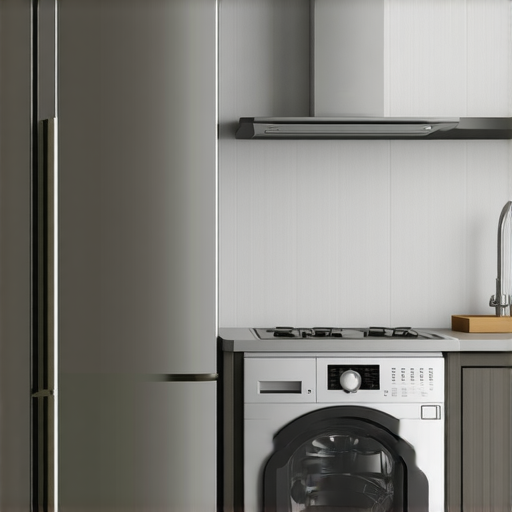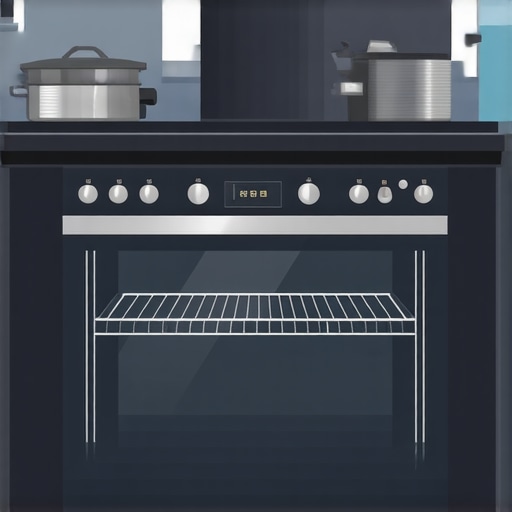My Journey to Understanding Oven Repairs
I’ll never forget the first time my oven stopped working right before a dinner party. Frustrated but determined, I dove into troubleshooting, which sparked my passion for oven diagnostics. That experience taught me the importance of knowing the key parts involved in oven repair and how to diagnose issues effectively.
Why Knowing Key Oven Parts Makes All the Difference
Understanding the main components such as heating elements, thermostats, and igniters helps me pinpoint problems faster. For example, a faulty heating element often results in uneven cooking, which I learned the hard way. Being familiar with these parts allows me to perform quick repairs, saving time and money.
How Do I Diagnose Common Oven Problems?
When my oven isn’t heating properly, I start by checking the diagnostics and essential parts. Using a multimeter to test the heating element or thermostat is a reliable method I swear by. This approach aligns with expert advice from trusted sources, which emphasizes the importance of accurate diagnosis for fast fixes.
What Are the Most Common Parts I Should Keep on Hand for Repairs?
In my toolbox, I always keep spare heating elements, thermostats, and igniters. Having these on hand has saved me countless trips to the store. If you’re interested in learning more about essential parts, I recommend exploring the comprehensive guide for fast repairs.
Sharing your experiences with oven troubleshooting can be incredibly helpful. Feel free to comment below with your tips or questions, and let’s build a community of DIY enthusiasts who master their appliances together!
Mastering the Art of Oven Troubleshooting: Advanced Tips for DIY Enthusiasts
As an experienced DIY repair expert, I know that diagnosing oven issues isn’t just about replacing parts—it’s about understanding the intricate interplay of components that keep your appliance running smoothly. One of the most overlooked yet critical aspects is recognizing the signs of failing parts before they cause complete breakdowns. For instance, inconsistent heating or strange odors often hint at worn-out thermostats or heating elements, which, if caught early, can save you significant time and money.
What Are the Hidden Complexities in Oven Diagnostics?
Beyond basic checks, advanced troubleshooting involves understanding the subtle clues that differentiate between similar symptoms. For example, a non-heating oven could be due to a defective igniter or a faulty control board. To accurately diagnose these issues, I recommend performing voltage tests on suspect components, which can be guided by trusted resources such as diagnostics and essential parts guides. This method ensures precise identification, preventing unnecessary replacements.
How Can I Leverage Diagnostic Tools for More Accurate Repairs?
Utilizing multimeters and specialized diagnostic tools can elevate your repair game. For example, testing the continuity of heating elements or verifying the signal output from thermostats provides concrete evidence of faults. Moreover, integrating diagnostic software with your multimeter can streamline troubleshooting, especially for complex control systems. Remember, understanding the wiring diagrams and component schematics is crucial—these can typically be found in service manuals or online technical resources.
Investing in quality replacement parts like those listed in comprehensive parts guides ensures longevity and reliable performance post-repair. Keeping a well-stocked toolbox with these essentials can significantly reduce downtime during repairs, making the process more efficient.
What Are the Practical Implications of Proper Diagnostics?
Accurately diagnosing oven problems extends beyond simple repairs—it impacts your appliance’s safety and energy efficiency. Incorrectly replacing a part without proper diagnosis might lead to further damage or even safety hazards like electrical shorts or gas leaks. Therefore, adopting a methodical approach, backed by expert advice and precise testing, is vital for long-term success.
For those eager to deepen their knowledge, I recommend exploring detailed diagnostic techniques outlined in this authoritative guide. Sharing your diagnostic triumphs or questions in the comments can also foster a community of skilled DIYers who support each other in mastering appliance repairs.
Unraveling the Complexities Behind Oven Troubles
Over the years of tinkering with my oven, I’ve realized that beneath its familiar exterior lies a web of intricate components that often challenge even seasoned DIYers. One of the most fascinating aspects I’ve encountered is how subtle signs, like a slight delay in heating or a faint smell of burnt wiring, can hint at deeper issues within the control board or sensor arrays. This experience has taught me to look beyond the obvious and develop a more nuanced approach to diagnostics, which involves detailed visual inspections combined with precise electrical testing.
The Nuanced Art of Voltage Testing and Its Pitfalls
While I always advocate for using a multimeter to verify component functionality, I’ve learned that voltage testing requires patience and a keen eye. For example, testing the thermostat’s voltage output during a heating cycle reveals not only if it’s functioning but also whether it’s responding correctly to temperature fluctuations. However, an incorrect reading can sometimes be misleading if the wiring isn’t properly secured or if the component is intermittently failing. As I delved into this, I discovered that consulting detailed schematics—like those available in comprehensive repair guides—is invaluable for accurate diagnosis.
What Are the Hidden Nuances in Diagnosing Control Board Failures?
One of the most challenging diagnostics I’ve faced involved pinpointing a defective control board. These boards can fail silently, with symptoms like inconsistent oven temperatures or unresponsive controls. The key is to perform a series of voltage and continuity tests on the control relays and integrated circuits, which often requires a detailed understanding of the wiring diagrams. I’ve found that learning to interpret these diagrams is akin to developing a new language—an essential skill for advanced troubleshooting. For comprehensive insights, I recommend exploring this detailed guide.
How Do External Factors Influence Diagnostic Accuracy?
External factors, such as power surges or moisture, can subtly impact oven components, leading to intermittent faults that are hard to reproduce during diagnostics. I’ve learned to consider environmental influences, inspecting for corrosion or corrosion-related resistance changes. Sometimes, simply unplugging the oven and letting it sit in a dry, warm environment for a few hours can reset minor faults, making troubleshooting more straightforward. This holistic approach, combining electrical diagnostics with environmental awareness, has significantly improved my repair success rate.
If you’ve ever faced similar challenges, I encourage you to share your experiences or ask questions in the comments. Learning from each other’s journeys makes us all better DIYers and helps demystify the complex world of oven repair. Remember, patience and continuous learning are your best tools on this path.
Delving into the Subtle Signs of Control Board Malfunctions
One of the most elusive challenges in oven repair is identifying silent or intermittent control board failures. Unlike obvious symptoms like non-response or complete shutdown, subtle clues—such as inconsistent temperature fluctuations or sporadic control panel glitches—often require a keen eye and a deep understanding of electronic schematics. Over time, I’ve learned to observe patterns, such as delayed responses to control inputs or unusual error codes, which hint at underlying control board issues. Recognizing these signs early can prevent more extensive damage and costly repairs.
How Do Power Surges and Environmental Factors Obscure Diagnostics?
External influences, including power surges, moisture, and temperature variations, can significantly complicate diagnostics. Power fluctuations may cause transient faults, leading to erratic oven behavior that mimics component failure. Moisture ingress can corrode sensitive circuit traces, resulting in intermittent connections that are hard to trace. I’ve found that ensuring a stable environment—by unplugging the appliance, inspecting for corrosion, and testing in controlled conditions—can reveal the true nature of the fault. Incorporating surge protectors and environmental controls into my diagnostic toolkit has improved my accuracy considerably.
What Are the Cutting-Edge Diagnostic Tools Elevating DIY Repair?
Beyond traditional multimeters, modern diagnostic tools like oscilloscopes and specialized circuit analyzers have revolutionized the troubleshooting process. Oscilloscopes allow me to visualize signal waveforms, helping identify anomalies in voltage or current that static measurements might miss. Additionally, software-based diagnostic interfaces, compatible with certain control boards, provide real-time error logs and system health reports. Investing in such tools, along with comprehensive wiring diagrams available in resources like this guide, enables precise pinpointing of faults—even in complex control systems.
Can External Power Quality Impact Diagnostic Accuracy?
Absolutely. Poor power quality, including voltage sags, surges, or electromagnetic interference, can cause false readings or mask actual faults. I’ve learned to use a line analyzer to monitor power conditions during diagnostics, ensuring that any irregularities are accounted for. Additionally, testing the oven in a different power outlet or using a dedicated circuit can eliminate external variables, leading to more reliable diagnostic outcomes. This holistic approach, considering environmental and electrical factors, is crucial for advanced troubleshooting.
Engage with My Deep-Dive Insights
If you’re eager to elevate your diagnostic skills and explore the intricacies of control board failures or external influence mitigation, I invite you to share your experiences or ask questions. Mastering these complex aspects not only enhances your repair confidence but also extends the lifespan and safety of your appliances. Dive into detailed guides like this authoritative resource and join a community committed to expert-level DIY troubleshooting. Remember, patience, curiosity, and continuous learning are your best allies on this journey.
Things I Wish I Knew Earlier (or You Might Find Surprising)
1. The Power of Visual Inspection
Early in my DIY journey, I underestimated how crucial a thorough visual inspection can be. I once replaced a heating element only to find out later that a tiny crack in a wire connector was causing the problem. Taking my time to visually check all components often saves me from unnecessary replacements and costs.
2. The Subtle Signs of Control Board Issues
I’ve learned that not all control board failures are obvious. Sometimes, delayed responses or strange error codes are the only clues. Recognizing these subtle signs has helped me diagnose issues before they escalate, saving time and frustration.
3. External Factors Matter
Environmental influences such as moisture or power surges can mimic component failures. I now always consider these factors and sometimes reset the oven or use surge protectors to ensure accurate diagnostics.
4. The Importance of Accurate Voltage Testing
Voltage tests are my go-to method, but I’ve realized that unstable wiring or intermittent faults can mislead my readings. Using detailed schematics and reliable tools makes a huge difference in the accuracy of my diagnostics.
5. Keeping a Well-Stocked Toolbox
Having essential spare parts like thermostats, igniters, and heating elements on hand has dramatically reduced my repair time. It’s a small investment that pays off when an unexpected failure occurs.
6. The Value of Continuous Learning
Every repair teaches me something new. Following forums, reading guides, and experimenting safely broaden my understanding and confidence.
Resources I’ve Come to Trust Over Time
- ApplianceBargainz.com: This website offers comprehensive repair guides and detailed schematics that have been invaluable for my diagnostics. It’s a trusted resource I recommend to fellow DIYers.
- Manufacturer Service Manuals: Official manuals provide accurate wiring diagrams and troubleshooting tips directly from the source, ensuring I follow the correct procedures.
- YouTube Channels like “Appliance Repair Tips”: Visual tutorials and step-by-step walkthroughs help me grasp complex concepts and techniques in an easy-to-understand way.
Parting Thoughts from My Perspective
Delving into oven repair has been a rewarding journey of patience, curiosity, and continuous learning. Understanding the key parts and diagnostic techniques has empowered me to fix issues confidently and save money. Remember, the key is to approach each problem methodically, leverage trusted resources, and never stop exploring. If this resonated with you, I’d love to hear your thoughts or experiences. Sharing our stories can inspire others and build a stronger DIY community. Happy troubleshooting!

